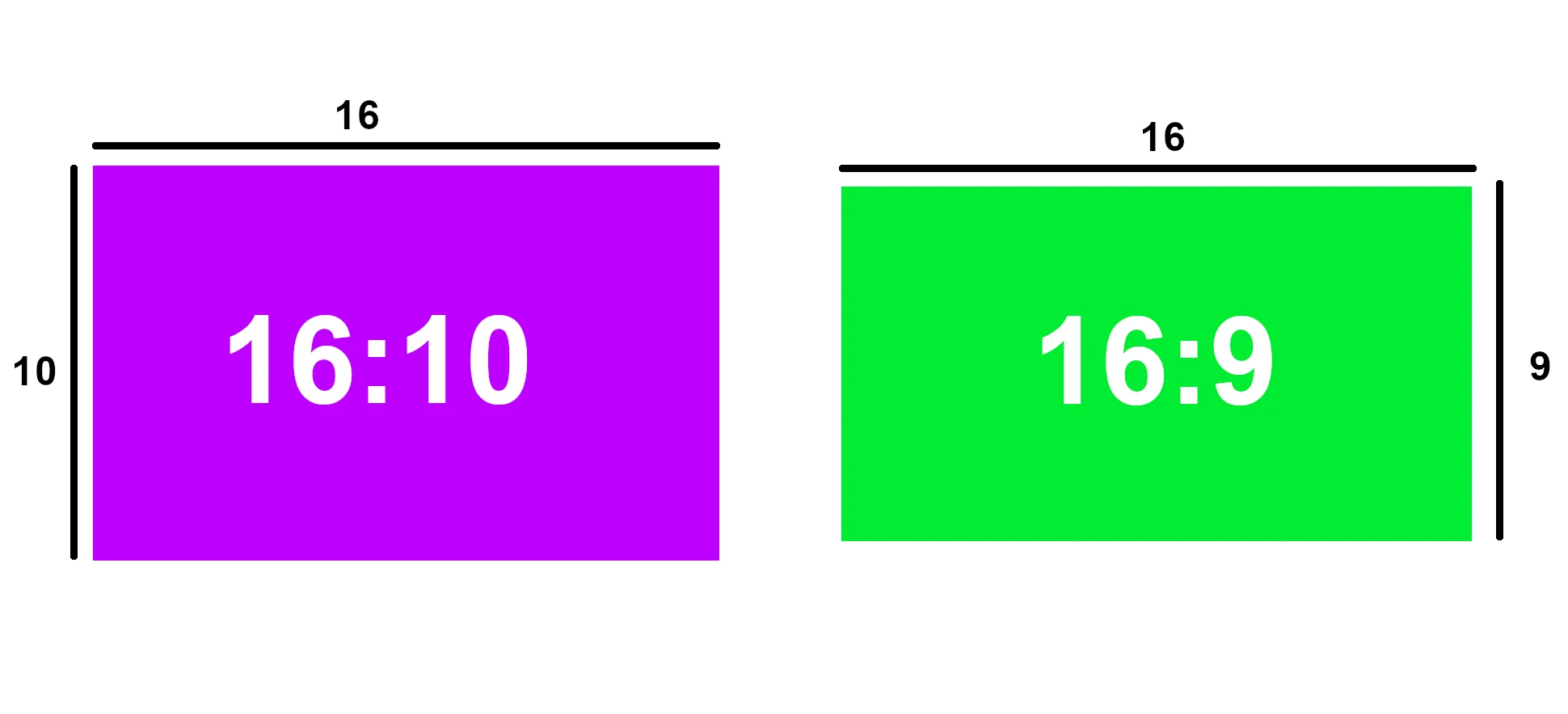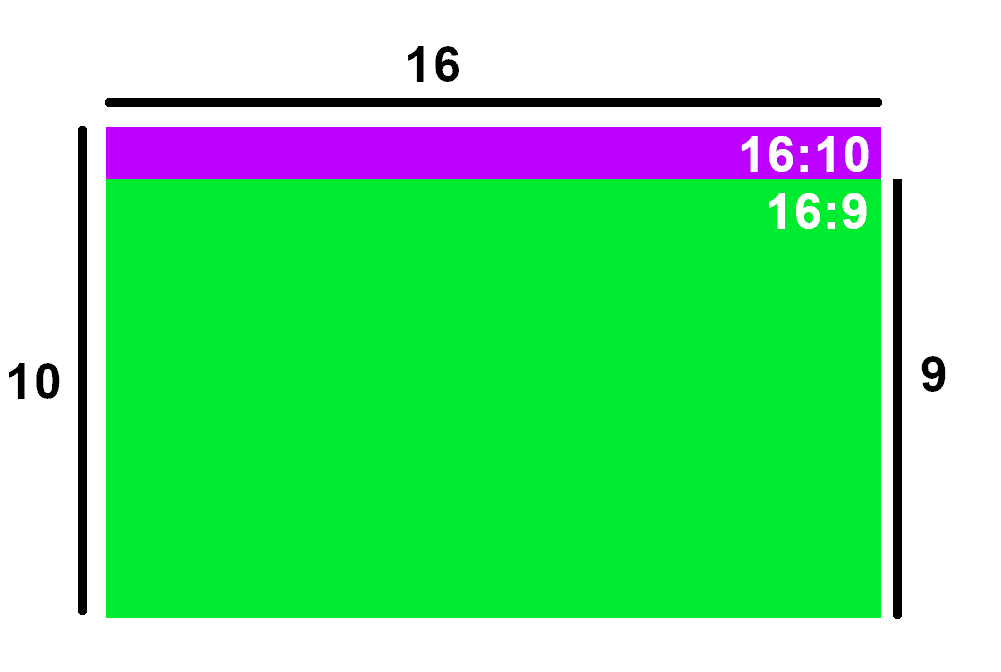In the world of displays, the aspect ratio plays a pivotal role in how we interact with and experience content. Two of the most popular aspect ratios today are 16:9 and 16:10. Although they may seem similar, their subtle differences can have a significant impact on your viewing experience, especially when it comes to productivity and entertainment. This guide aims to clarify these two aspect ratios, providing you with the knowledge needed to make an informed decision when choosing your next monitor or laptop.
By considering the pros and cons of each, you’ll be equipped to select the aspect ratio that best suits your needs and preferences, ensuring a more enjoyable and productive experience. When it comes to choosing the right monitor, whether for work, gaming, or general use, one often overlooked aspect is the screen’s aspect ratio. The two most common aspect ratios in today’s market are 16:9 and 16:10. This article delves into the intricacies of these aspect ratios to help you make an informed decision.

Choosing the Right View: 16:9 vs. 16:10 Aspect Ratios
Understanding Aspect Ratios
An aspect ratio defines the proportional relationship between the width and height of a display. It’s expressed as two numbers separated by a colon (e.g., 16:9 or 16:10). The first number represents the width, and the second number represents the height.
16:9: The Widescreen Standard
16:9 is the most common aspect ratio found in TVs, monitors, and laptops today. It provides a wide horizontal space, ideal for watching movies and playing games, as most content is produced in this format.
Pros:
- Widely available: Most content is created for 16:9, ensuring compatibility and minimizing black bars.
- Immersive experience: The wide format is great for movies and games, offering a cinematic feel.
- Affordable: Monitors and laptops with 16:9 displays are generally less expensive.
Cons:
- Limited vertical space: Less vertical space can hinder productivity tasks like coding, browsing, and document editing.
- Black bars on some content: Older movies or videos not formatted for 16:9 may display with black bars on the top and bottom.

16:10: The Productivity Powerhouse
16:10 offers slightly more vertical space than 16:9, making it a favorite among professionals and productivity enthusiasts. The extra height is beneficial for viewing documents, spreadsheets, and code, allowing you to see more content without scrolling.
Pros:
- Increased vertical space: Enhances productivity tasks, reducing the need for scrolling.
- Better for multitasking: The taller display accommodates more windows or apps side-by-side.
- Preferred by some creatives: Can be useful for photo and video editing due to the extra vertical space.
Cons:
- Less common: Finding monitors and laptops with 16:10 displays might be more challenging.
- Potential for black bars: Some movies and games may display with minor black bars on the sides.
- Slightly higher cost: 16:10 displays can sometimes be slightly more expensive.
Comparison Table
| Feature | 16:9 Aspect Ratio | 16:10 Aspect Ratio |
|---|---|---|
| Shape | Wider and shorter | Slightly taller and narrower |
| Common Uses | Movies, gaming, general entertainment | Productivity, multitasking, creative work |
| Availability | Widely available | Less common |
| Price | Generally more affordable | Can be slightly more expensive |
Comparing 16:9 and 16:10 Aspect Ratios: Features
| Feature | 16:9 | 16:10 |
|---|---|---|
| Shape | Wider than tall | Slightly taller than 16:9 |
| Aspect Ratio | 1.77:1 | 1.6:1 |
| Horizontal pixels | 1920 (common), 2560 (common), 3840 (4K) | 1680 (common), 1920 (common), 2560 (common) |
| Vertical pixels | 1080 (common), 1440 (common), 2160 (4K) | 1050 (common), 1200 (common), 1600 (common) |
| Common Use Cases | TVs, most monitors, gaming, movies | Productivity, creative work, some laptops |
| Pros | Wide viewing area, immersive experience for videos and games, more common and often cheaper | More vertical space, better for reading text and viewing documents, can feel more natural for some users |
| Cons | Less vertical space, can feel cramped for productivity tasks | Less common and often more expensive, not as widely supported in games and videos |
Here are some additional points to consider:
- 16:9 is the most common aspect ratio for monitors and TVs, so you’ll have a wider range of options to choose from.
- 16:10 is often preferred by productivity users and creative professionals who value the extra vertical space.
- Gamers typically prefer 16:9 for its wider field of view and compatibility with most games.
- Some people find 16:10 to be more comfortable for general use as it more closely matches the natural field of view of the human eye.
Understanding Aspect Ratios
An aspect ratio is essentially the ratio of a screen’s width to its height. It plays a crucial role in how content is displayed, affecting everything from your productivity in work applications to your experience in gaming and watching movies.
The Rise of 16:9
The 16:9 aspect ratio, widely recognized as the standard for high-definition television and movies, offers a broader horizontal space. This ratio is particularly advantageous for multimedia consumption like watching films or playing widescreen-format games, as it aligns perfectly with the 1920×1080 (Full HD) and 2560×1440 (QHD) resolutions.
The Appeal of 16:10
On the other hand, 16:10 provides extra vertical space, making it ideal for productivity tasks. Applications like coding, document editing, and spreadsheet management benefit from the additional lines visible without scrolling. This aspect ratio, typically sporting resolutions like 1920×1200 or 2560×1600, caters to a niche audience prioritizing work and multitasking efficiency.
User Experiences and Reviews
In a comprehensive review on bit-tech.net, the author shared a hands-on comparison between these aspect ratios. They noted the considerable loss of vertical screen real estate when moving from a 16:10 to a 16:9 monitor, impacting the efficiency of viewing web pages and documents. A 24-inch monitor with a 16:10 aspect ratio was preferred over a larger 27-inch 16:9 monitor, highlighting the practicality of additional vertical space.
The Verge also chimed in on this topic, emphasizing a shift away from the 16:9 standard in the laptop industry. The article pointed out that 16:9 screens often feel cramped, especially when multitasking or working with multiple windows. This discomfort has led to a growing trend of laptops featuring 16:10 or even 3:2 aspect ratios, offering more efficient use of screen space.
Practical Implications
Let’s delve into how these aspect ratios fare in different scenarios:
For Multimedia Enthusiasts
If your primary use involves watching movies or playing games, 16:9 is your go-to. It perfectly aligns with most media formats, providing an immersive, full-screen experience without black bars or cropped scenes.
For Professionals and Multitaskers
If you find yourself juggling various applications, 16:10 offers a significant advantage. The extra vertical space allows for more content to be displayed, reducing the need to scroll and making it easier to work with large documents or spreadsheets.
Summary of Facts
- 16:9 is ideal for multimedia, aligning with standard resolutions like Full HD and QHD.
- 16:10 provides additional vertical space, enhancing productivity and multitasking.
- User reviews favor 16:10 for work-related tasks due to less scrolling and more content visibility.
- The industry is observing a shift towards taller aspect ratios for laptops, as noted by The Verge.
FAQs
What are the best use cases for a 16:9 aspect ratio?
16:9 is best suited for watching movies and gaming, where a wide horizontal field is preferred.
Why might someone prefer a 16:10 aspect ratio?
16:10 is preferred for productivity tasks like document editing, coding, and spreadsheet management, offering more vertical space.
Is there a trend in laptop screens moving away from 16:9?
Yes, as per The Verge, there’s a growing trend of laptops adopting 16:10 or 3:2 aspect ratios for more efficient screen space usage.







